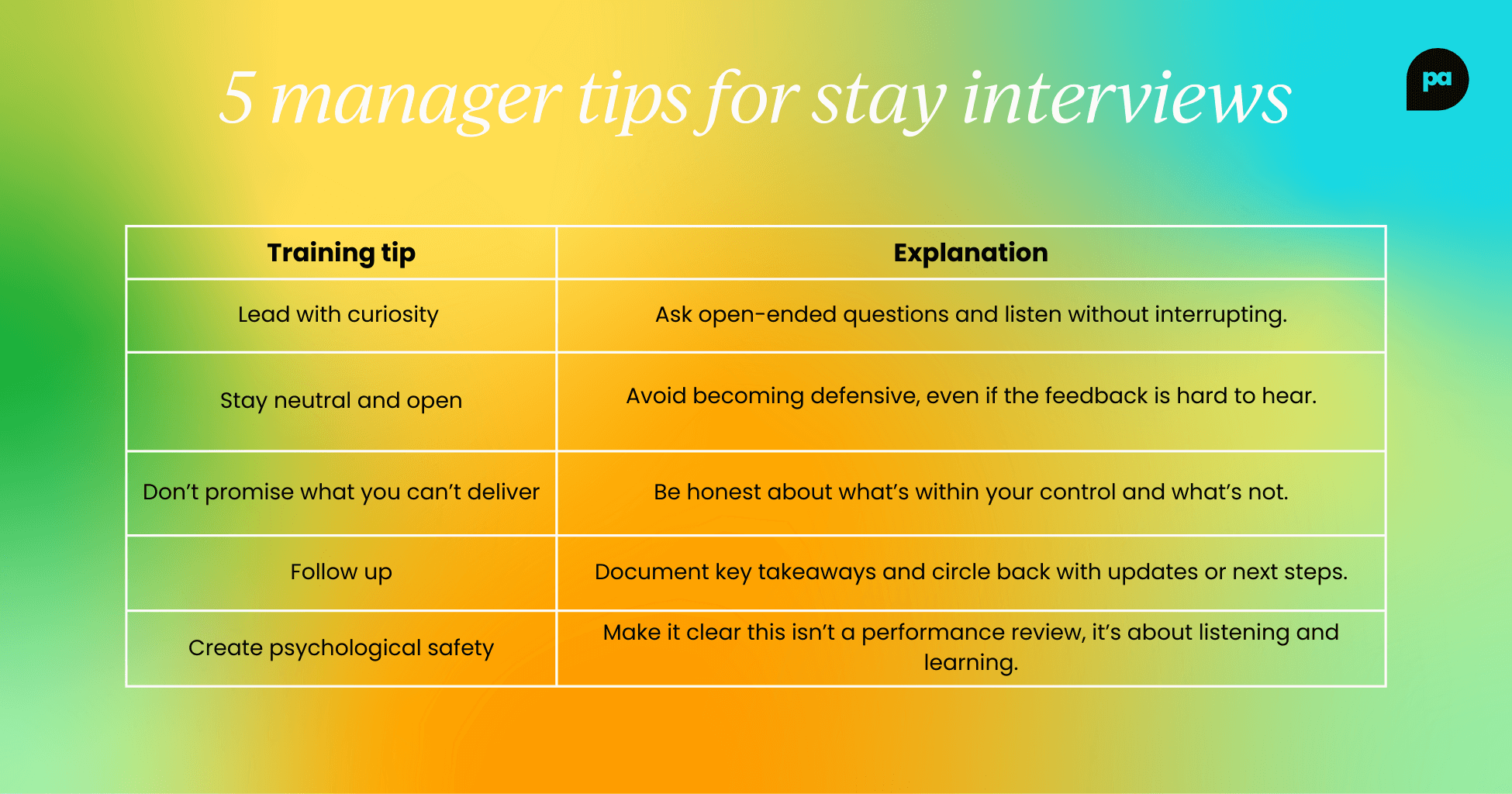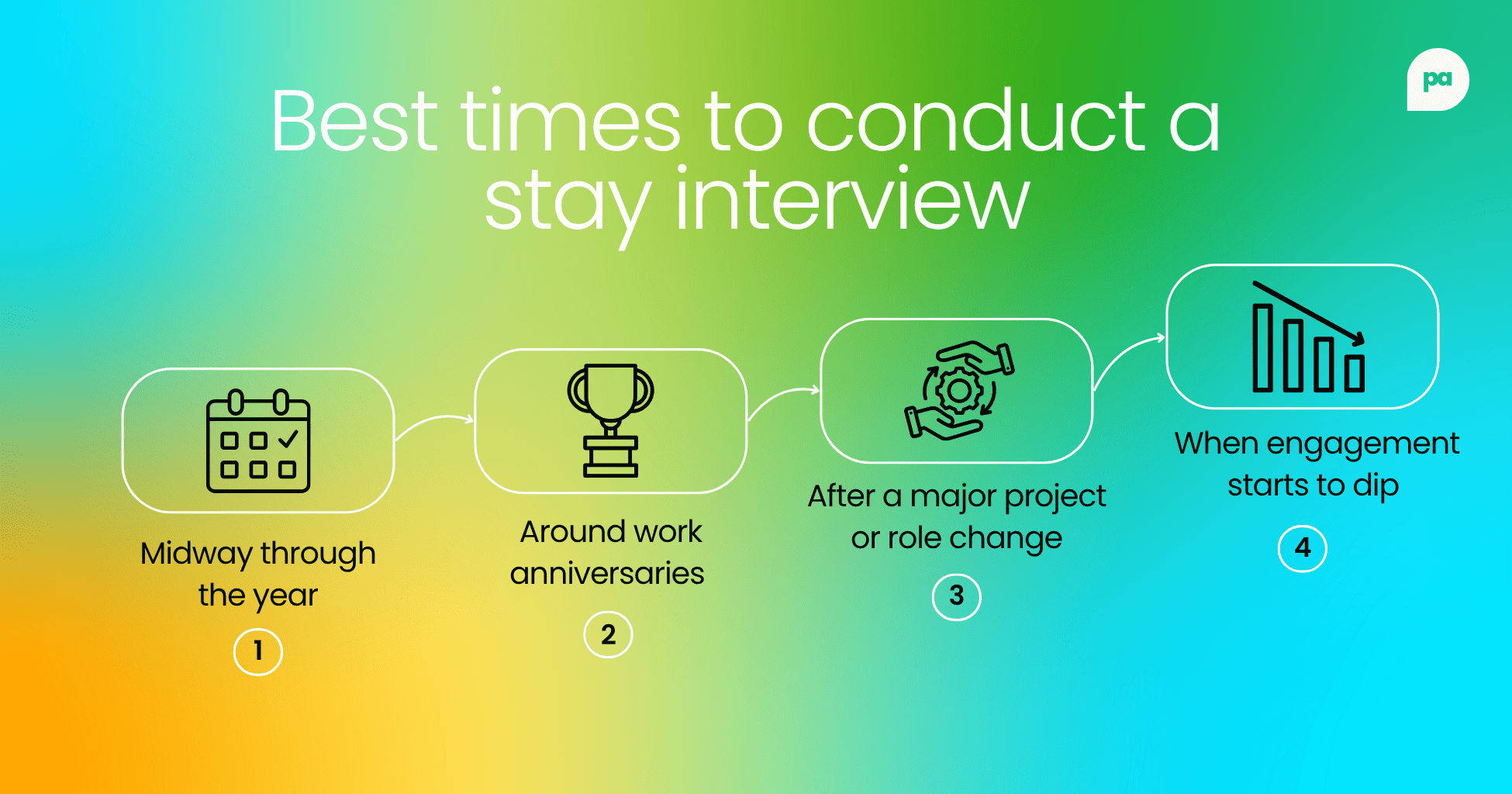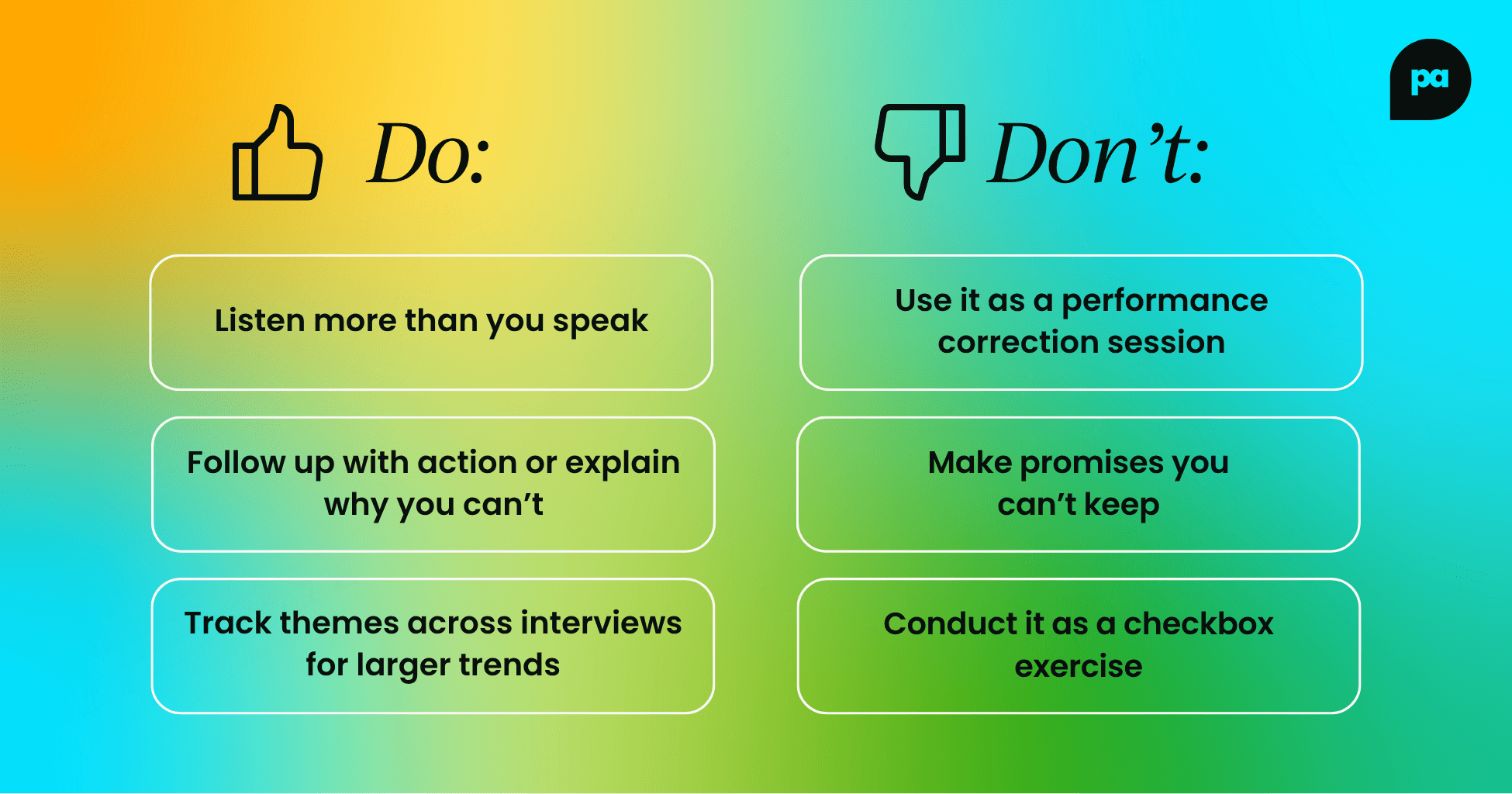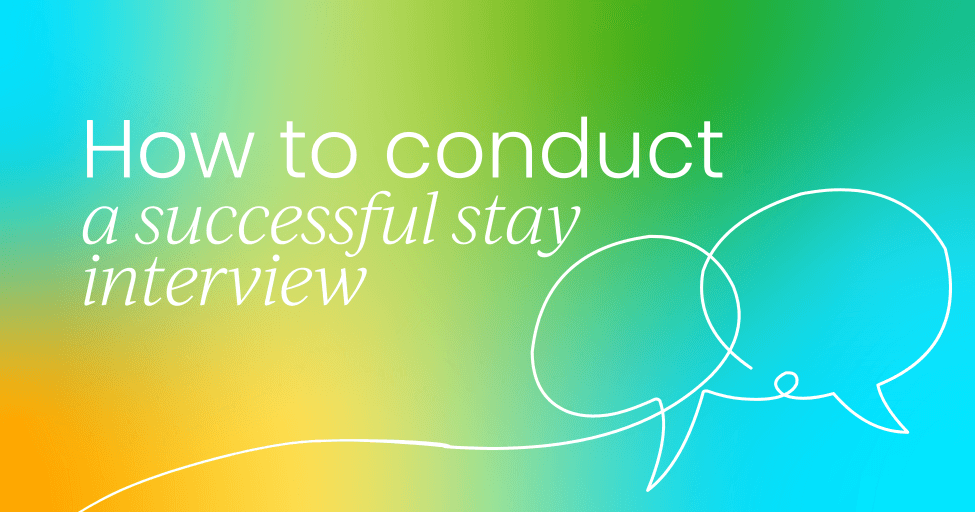Most companies wait until employees are walking out the door to ask why they’re leaving. But what if you asked before they made that decision?
That’s the purpose of a stay interview, which is a focused conversation to uncover what keeps employees engaged, what might push them away, and how you can support them better. It’s like an exit interview, but instead of using it to understand why you lost an employee, you use it to help retain talent.
We’ll break it down in more detail and give you top tips to help you run an effective stay interview and learn more about who should be involved, the best questions to ask, avoiding common challenges, and more.
Plus, don’t forget to download your free Stay Interview Template to help you get started!
What is a stay interview?
A stay interview is a structured, one-on-one conversation between a manager and an employee with a simple goal: to understand what motivates them to stay at the company and what might cause them to leave.
Unlike performance reviews, which focus on past results, or exit interviews, which happen too late, stay interviews look forward. They give employees space to share honest feedback about their experience, career goals, and what they need to thrive.
These conversations aren’t just about fixing problems on the spot. Instead, they’re about listening, building trust, and identifying opportunities to improve engagement before someone becomes a flight risk.
- Uncover patterns across teams.
- Highlight cultural strengths and gaps.
- Reduce turnover.

Who should conduct stay interviews?
The success of a stay interview can really depend on who’s asking the questions. Ideally, it should be someone the employee trusts and interacts with regularly. So, their direct manager is often the best choice.
That said, HR professionals or people leaders can also play an important role, especially if:
- The manager-employee relationship lacks trust.
- The employee requests a neutral party.
- The company wants to identify broader cultural themes through HR-led interviews.
Whoever conducts the stay interview must be trained to listen openly, avoid defensiveness, and follow through (or communicate transparently if they can’t). Otherwise, the conversation can do more harm than good.
Here are a few key tips to help managers create a safe, productive environment during these conversations:

Who should receive a stay interview?
Stay interviews shouldn’t be reserved for your top performers or people you suspect might be thinking of leaving. Every employee can benefit from the chance to share how they’re feeling and every manager can benefit from hearing it.
That said, you can be strategic about how you roll them out:
- Start with high-impact roles or teams where retention is most critical.
- Include employees in their first year, who may be silently struggling to settle in.
- Check in with long-tenured employees, who might feel overlooked or stagnant.
- Don’t overlook underrepresented groups whose experiences may differ from the majority.
The key is to avoid bias. If you only offer stay interviews to a select few, you risk creating resentment or missing valuable insights.
When should you conduct stay interviews?
The best time to hold a stay interview is before there’s a problem. These conversations work best when they’re proactive, not a last-minute retention tactic.

Start with quarterly or biannual check-ins if you're new to the process. Just avoid peak stress periods when employees are too overwhelmed to engage meaningfully.

How to conduct a stay interview
Conducting a stay interview isn’t complicated but it does help if you’ve got some sort of structure to follow. So, here’s a simple step-by-step approach to make these conversations meaningful and effective:
1. Set the stage intentionally
Frame the conversation with clarity and purpose.
Let the employee know what the conversation is, and what it isn’t. Make sure they know that the stay interview isn’t a performance review or disciplinary talk. It’s a chance to hear their honest thoughts about their role, growth, and experience. It’s also good to give them a heads-up a few days in advance so they can reflect and prepare for the meeting.
2. Create psychological safety
Start with a tone of curiosity, not critique.
Your role here is to listen. So, right from the beginning, make sure to have the conversation in a relaxed, non-defensive way and choose a comfortable setting (or virtual space) where the employee can speak freely.
Express genuine interest in their experience and be clear that their feedback won’t be used against them. All of this will help to establish psychological safety and make the entire experience a lot more positive.
3. Ask open, future-focused questions
Focus on what keeps them engaged, and what could make things better.
The most effective stay interview questions are open-ended and structured to uncover what motivates them, where they feel stuck, and what support they need. Avoid yes/no questions or anything that sounds like a trap.
4. Listen, don’t solve immediately
Prioritize comprehension over immediate resolution.
Resist the urge to jump into problem-solving mode. Stay interviews are about gathering insights, not defending current practices or promising instant changes. Take notes, reflect back what you heard, and thank them for their honesty.
5. Accountability and follow-through
Transform insights into credible action.
After the conversation, summarize what you heard and identify what actions (if any) you can take. For bigger issues, loop in leadership as needed. Even if nothing changes immediately, simply closing the loop helps to build credibility.
Stay interview best practices
Stay interviews can be great for building trust, keeping teams engaged, and holding onto your best people. But if they're not handled well, they can feel like a total waste of time, or even worse, actually damage team morale.
So, here are some tips to get them right:

Do:
✔ Listen more than you talk: Remember that a stay interview is more of a listening session than a performance discussion. So, focus the conversation on understanding their experience and what matters most to them.
✔ Follow up with action: If you can address their feedback, do it. But if you can’t, or at least not right away, be honest about why. The worst outcome is silence after a vulnerable conversation.
✔ Look for patterns across interviews: Don’t treat each conversation in isolation. Instead, look for shared concerns or recurring themes you can address at a team or organizational level.
Don’t:
✘ Use it to correct performance: A stay interview shouldn’t be used as a coaching session. If it turns into one, you’ll lose the trust needed for real honesty.
✘ Make promises you can’t keep: It’s tempting to offer quick fixes, but it’s better to say, “Let me look into that” than to overpromise and underdeliver.
✘ Conduct them as a checkbox exercise: If it feels rushed or scripted, employees will sense it. Make an effort to approach each one with real curiosity and intention.

Stay interview questions to ask
The quality of your stay interview depends on the quality of your questions. The goal is to spark an open, honest dialogue and use open-ended prompts that invite employees to reflect on what’s working, what’s not, and what they need more of to stay engaged.
Here are some tried-and-true stay interview questions to include in your stay interview, along with what they can uncover:
1. What do you enjoy most about your role right now?
Reveals engagement drivers and what they find fulfilling.
2. What would make your work experience even better?
Uncovers practical ideas for improving day-to-day satisfaction.
3. What skills or talents do you feel are underused?
Highlights opportunities for growth, stretch assignments, or role alignment.
4. What might tempt you to leave the company?
Surfaces potential risk factors before they turn into resignations.
5. Do you feel recognized for your contributions? Why or why not?
Explores their sense of value and belonging.
6. How supported do you feel by me (or your manager)?
Provides insight into the employee-manager relationship and leadership gaps.
7. What are your long-term goals, and how can we help you reach them?
Shows investment in career development and retention planning.
8. What’s one thing you would change about your role or team?
Encourages candid feedback on process, structure, or dynamics.
Ready to start having better stay interviews?
Take the guesswork out of the process with our free Stay Interview Template. It includes ready-to-use questions, tips for conducting a successful interview, and a simple structure to help you turn conversations into real retention strategies.
Download the Stay Interview Template now and start building stronger, more engaged teams, one conversation at a time.



 Follow us on LinkedIn
Follow us on LinkedIn



